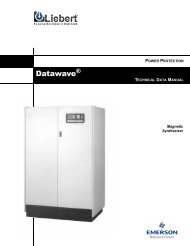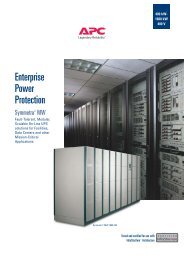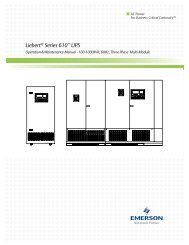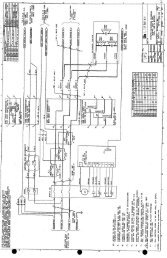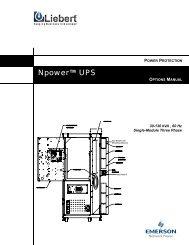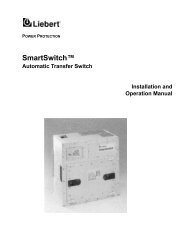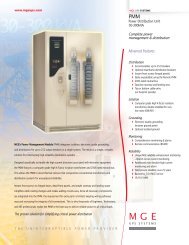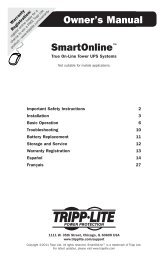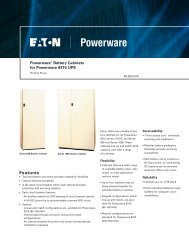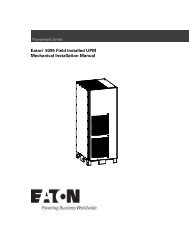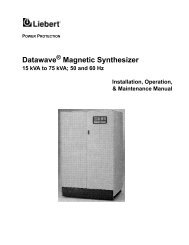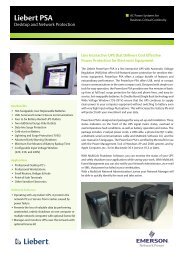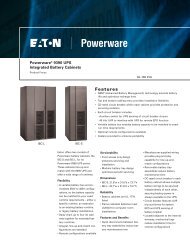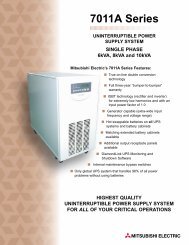NetSure ITM Installation Manual - Gruber Power
NetSure ITM Installation Manual - Gruber Power
NetSure ITM Installation Manual - Gruber Power
Create successful ePaper yourself
Turn your PDF publications into a flip-book with our unique Google optimized e-Paper software.
Positioning the DC UPS System<br />
3.0 POSITIONING THE DC UPS SYSTEM<br />
This section describes the environmental and mechanical considerations that must be taken into<br />
account when planning the positioning and cabling of the DC UPS system. This section also provides<br />
procedures for physical installation of the DC UPS cabinet.<br />
Because every site is unique, some subsections present a guide to general procedures and practices<br />
that should be observed by the installing engineer, rather than step-by-step installation instructions.<br />
3.1 General Requirements<br />
• The installer should be familiar with the installation requirements and techniques to be used in<br />
securing the DC UPS module (cabinet) to the floor. It is up to the customer to determine the<br />
requirements for anchoring the cabinet to the specific type of floor at the site, select proper<br />
anchors, and to investigate the proper use of the anchor.<br />
• This product is intended only for installation in a Restricted Access Location on or above a noncombustible<br />
surface.<br />
• Front and rear access is required for installation and operation (see Clearances in this section).<br />
3.2 General Guidelines for Positioning the DC UPS Modules<br />
Choose a location for the DC UPS system that offers:<br />
• Easy connection to inputs, outputs, and alarms.<br />
• Air circulation sufficient to expel heat produced by the DC UPS system.<br />
• Protection against moisture and excessive humidity.<br />
• Protection against dust and other particulate matter.<br />
• Enough space to service the DC UPS system (see Clearances in this section).<br />
• Compliance with fire prevention regulations and practices.<br />
3.2.1 Cable Entry<br />
DC distribution and alarm cables enter the DC UPS module from the top or bottom, depending on<br />
module configuration (top distribution feed or bottom distribution feed).<br />
AC input cables can enter either at the top or bottom. Conduit openings are provided in both locations.<br />
3.2.2 Environmental Considerations<br />
Before installing the DC UPS system, verify that the room satisfies the environmental conditions<br />
stipulated in 7.2 - Environmental, paying particular attention to the ambient temperature and air<br />
exchange system. Also refer to 7.2 - Environmental for details on heat dissipation.<br />
The DC UPS system should be installed in a cool, dry, clean-air environment with adequate ventilation<br />
to keep the ambient temperature within the specified operating range +23°F to +95°F (-5°C to<br />
+35°C).<br />
• Batteries are installed in the DC UPS module’s battery compartment. Temperature is a major factor<br />
in determining battery life and capacity. Battery manufacturers recommend an operating<br />
temperature of 77°F (25°C). Ambient temperatures higher than this reduce battery life; temperatures<br />
lower than this reduce battery capacity. For optimal battery performance and service life,<br />
inlet air temperature to the battery compartment (from the front of the system) should be maintained<br />
between +68°F to +77°F (+20°C to +25°C).<br />
The DC UPS module is cooled by internal fans. Cooling air enters the system through the front of the<br />
unit and is exhausted out the top. To permit proper air flow and prevent overheating, do NOT block or<br />
cover the ventilation openings or blow air down onto the unit. Ventilation clearance above the unit<br />
must be a minimum of 8 in. (203mm).<br />
13



